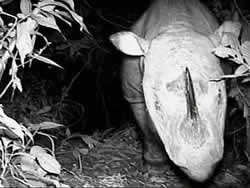
May 7, 2007

Dicerorhinus sumatrensis harrissoni
Earlier on Cryptomundo, Craig Woolheater uploaded the video footage of the Borneo rhinoceros, here.
Now the media is taking video captures from the footage and publishing them. Some who are not reading too carefully will think there is “new” news of the filming of a Borneo Rhino, but this is merely the continued cycling of an updated Reuters dispatch about the recent announcements from April.
For example, The Daily Times of Pakistan for May 7, 2007, is reporting that the two-horned Borneo rhinoceros (Dicerorhinus sumatrensis harrissoni), a subspecies of the Sumatran rhino, has been filmed (see video capture above) despite no sightings having been confirmed for 20 years. They are discussing the April news today as if it is breaking news.
Of course, there are unconfirmed reports of this subspecies, also called the Eastern Sumatran Rhinoceros, surviving in Sarawak and Kalimantan, and we do have to be aware that future “first” photos may be coming from there.
There may be no more than 25 to 50 of the rhinos in the dense rainforests deep in the heart of the Malaysian state of Sabah on Borneo. In Sarawak and Kalimantan, the subspecies may already be extinct. Surprises could be in store. But two week old news about earlier footage is not “new” news.
The Borneo subspecies is distinct from those in Indonesia and the Malaysian peninsula, so things do get muddy when talking about the three subspecies of Sumatran rhinos and who has filmed what. The Indian rhino, which has one horn, is even more different.
This April-released two-minute footage shows the Borneo rhino sniffing the camera, breathing heavily, eating, and walking about. It is the first film ever taken of this specific species of rhino on Borneo. The camera hidden in the jungle took the video in February 2007, but the WWF only released it on April 24-25, depending on your time zone. Once again, go here to view that footage.
Dicerorhinus sumatrensis harrissoni is being discussed again merely due to the release of the above newly distributed video capture, it seems, and because some editors wait for slow days to talk about animal stories.
This is, however, not to be confused with the few years old footage of the Sumatran rhinoceros in the 47 minute Asia Geographic documentary produced by James Reynolds and Mike Cabarles featuring seven Sumatran Rhinos in West Malaysia and two in Sepilok, Sabah. It is uncertain if that Sabah rhino was the Borneo subspecies.
This first-ever video of Borneo’s Dicerorhinus sumatrensis harrissoni, also, is not directly linked, as well, with the first photograph of a Borneo rhino announced the first week of September 2006, which you may read about here.
In the story of the Borneo rhinos, there appear to be many “firsts.”
For even more on the Borneo discoveries from last September 2006, see my blog on the “Sumatran Rhino Discovered in Borneo Jungles,” with other images of what other subspecies of the Sumatran rhinos look like and how they overlap with the Ice Age’s wooly rhinos.
The Javan Rhinoceros (Rhinoceros sondaicus), a neighboring island’s very rare other rhino, with only 60 or so existing, live in Java, Indonesia and Vietnam. Like the Indian rhino (Rhinoceros unicornis), to which they are closely related, the Javan have a single horn. The critically endangered Sumatran rhinos (with three subspecies, one of which is the Borneo variety) is the only surviving representative of the Dicerorhinini, which emerged in the Miocene (about 20 million years ago). The extinct Woolly Rhinoceros of northern Europe and Asia was also a member of this most primitive of all the groups of rhinoceros.
About Loren Coleman
Loren Coleman is one of the world’s leading cryptozoologists, some say “the” leading living cryptozoologist. Certainly, he is acknowledged as the current living American researcher and writer who has most popularized cryptozoology in the late 20th and early 21st centuries.
Starting his fieldwork and investigations in 1960, after traveling and trekking extensively in pursuit of cryptozoological mysteries, Coleman began writing to share his experiences in 1969. An honorary member of Ivan T. Sanderson’s Society for the Investigation of the Unexplained in the 1970s, Coleman has been bestowed with similar honorary memberships of the North Idaho College Cryptozoology Club in 1983, and in subsequent years, that of the British Columbia Scientific Cryptozoology Club, CryptoSafari International, and other international organizations. He was also a Life Member and Benefactor of the International Society of Cryptozoology (now-defunct).
Loren Coleman’s daily blog, as a member of the Cryptomundo Team, served as an ongoing avenue of communication for the ever-growing body of cryptozoo news from 2005 through 2013. He returned as an infrequent contributor beginning Halloween week of 2015.
Coleman is the founder in 2003, and current director of the International Cryptozoology Museum in Portland, Maine.
Filed under Breaking News, Cryptotourism, CryptoZoo News, Cryptozoologists, Cryptozoology, Evidence, Expedition Reports, Eyewitness Accounts, New Species, Photos, Videos